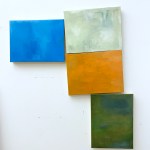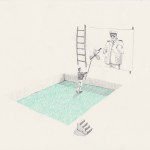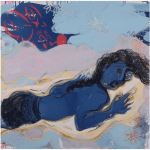
Contributed by Jason Andrew / Lucy Mink was the first artist I came to know solely through Facebook. She didn�t live in Brooklyn but in rural Contoocook, New Hampshire, and I became cyber-obsessed, waiting for each new post from her studio. What I saw then and continue to see today in Mink�s work is an embrace of the kind of American modernism established by artists including, notably, Arthur Dove and Georgia O�Keeffe. Mink�s paintings, like Dove�s, reflect a desire to capture �the play, or swing of space� as felt through a tapping of the unconsciousness. And, as I�ve written about O�Keeffe�s work, Mink�s is assertive in its composition and deliberate in its brushwork. This quality distinguished O�Keeffe and now makes Mink one of my favorite contemporary artists. Eventually I invited her to do a show at Outlet Fine Art, the gallery I once co-owned with John Silvis and Julian-Jimarez. It wasn�t until then, when she delivered the work and we installed the exhibition, that we finally met face-to-face.
Lucy�s studio is just an hour or so from the White Mountains. Anticipating the end of the summer and my return to Brooklyn from my house in Jay, New York, I sent her a DM on Instagram. She put a fishing trip with her kids on hold, and we arranged for me to stop and visit as I drove southeast. With the neighbor�s chickens darting underfoot, I stepped into her studio.


Jason Andrew: What has changed most in the work since our show together in 2015?
Lucy Mink: There are more lines, and as I still continue to draw with the paint, I see looser areas. In grad school I got really expressive and my marks changed. Maybe I want to go there again. I often check back in on what I did in the past, while adding what I have learned about paint. As I work it all depends on the day; today for instance I am being really careful with my edges. Other days I am not. I think things will continue to change as I get more room to leave stuff out (imagine expanding my studio to the upstairs of this house).
Some of it also relates to what is going on in the world, my head, the day. There are a lot more boxes and closed-in spaces in the paintings I�m working on now. Some have many thin layers, whereas others, like the ones I showed at Outlet, have a lighter feel. Also the work I showed in Brooklyn had a lot of movement. I�ve also been limiting my palette, which is something I seem to do every now and then to get myself to go somewhere else, but also as a way to get the most out of, let�s say, a certain green or a red, and how the two interact. When I think back to when I painted vacation and then went on to paint other big ones after that, I remember how great it was to be making those paintings. I like painting them more than I like them when they are done. Last year was like that, too. Prior to the residency I had the bigger paintings going along with the small ones in my studio, and there was this day, I must have had the news on, and I remember titling a painting 2038 because I just wanted to skip ahead and hope things could be better. Now, for the most part, I listen to music in my studio and the car, and I read the news.


JA: Your recent residency at Dartmouth involved printmaking. How did the process affect your paintings? Compositionally? Process?
LM: I had been thinking about printmaking all summer before the residency started. Or completely committing myself to working in the ceramics studio.
Right after my artist�s talk, Prof. John Kemp Lee came up to me and said, �You should do printmaking,� and it felt like a mind-reading moment. It turned out to be the best place for me while there because I could experiment and make prints that had a relationship to my old paintings. Then I started doing new things with ink layers that were similar to how I paint. These ideas went into new oil paintings in my Dartmouth studio. I often limited my ink color choices, and when I went into the print studio I would stay for 6-7 hours if I could. Uninterupted, I was able to just draw and print, and I developed this whole process of not always cleaning my plate and learning to work with what was there. Just adding and subtracting.

JA: You seem to be playing with lots of different sizes of canvases… moving away from a kind of verticality present in the paintings we featured in your show in 2015. Is this new? Or am I just becoming more aware?
LM: I have always painted both very tiny paintings and larger ones if I can. It�s true I have been painting more horizontal paintings this year, and, for the most part, the monoprints are horizontal except for a few here and there. Prof. Esme Thompson gave me an odd shaped panel that I stretched linen over and I want to work more with odd shapes going forward as well, but I don�t want to choose the shapes. I like that she just gave this to me.
Eventually, fishing pole in hand, Lucy said goodbye. This is the best use of Facebook I know.

About the author: Jason Andrew is an independent scholar, curator, and producer who co-founded and directs Norte Maar, a non-profit organization that creates, promotes, and presents collaborative projects in the arts. Followed him on Twitter @jandrewARTS.
Related posts:
Blast of color: Mink and Dolnick at OUTLET
Ginny Casey: Disembodied hands and lumps of clay in Philadelphia
Interview: Victoria Roth at Brennan & Griffin
Interview: Magalie Gu�rin�s multiple endings















I can see why you became a fan, the work has a quality that pull you into to the visual textures brought about though great precision.
Such a great and dedicated painter!
Really enjoyed the interview.